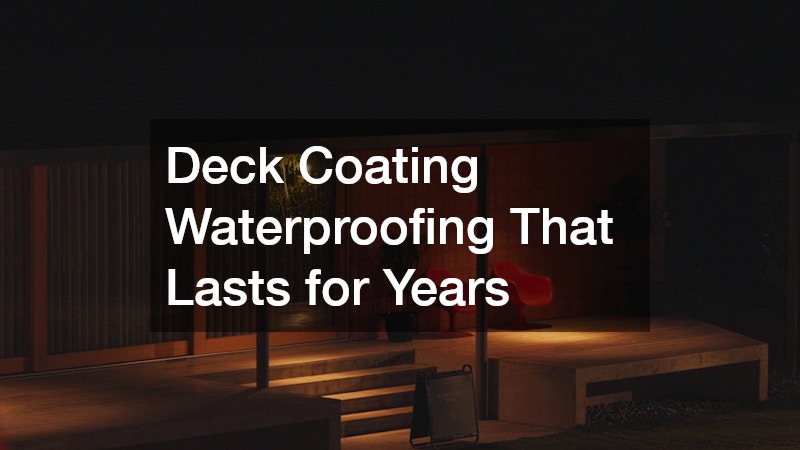
Decks are one of the most cherished features of a home, offering a comfortable space to relax, entertain guests, or simply enjoy the beauty of the outdoors. Yet, this open-air exposure also makes them vulnerable to the damaging effects of rain, sun, wind, and temperature fluctuations. Over time, these elements can cause fading, warping, cracking, or rot, ultimately shortening the deck’s usable life. Without proper protection, even the most well-built deck will eventually show signs of wear, leading to expensive repairs or premature replacement.
Deck coating waterproofing serves as the first line of defense against these challenges. By sealing out moisture and shielding the surface from UV rays, it preserves the deck’s beauty and strength.
Beyond protection, a well-maintained waterproof layer enhances safety by preventing slippery conditions caused by water damage. In the following sections, we’ll look at proven methods for long-term deck waterproofing, including smart material choices, thorough preparation techniques, and ongoing maintenance practices that keep your deck looking and performing its best.
What is the Best Deck Coating for Long-Term Waterproofing?
Types of Deck Coating Materials
There are several types of deck coating materials, each offering unique benefits for waterproofing. Polyurethane coatings are known for their durability and resistance to wear, making them an excellent choice for high-traffic decks. While silicone-based coatings provide superior flexibility and UV resistance, ensuring that the deck surface remains crack-free over time. On the other hand, epoxy coatings offer a hard, protective surface that resists water intrusion effectively, albeit being generally more expensive.
Comparison of Deck Coating Products
When choosing a deck coating product, consider factors like durability, application ease, and cost-effectiveness. Products such as Liquid Rubber Waterproof Sealant have gained popularity due to their easy application and long-lasting protection against water damage. For those prioritizing eco-friendliness, the Ames Safe-T-Deck is a viable option, offering reliable waterproofing without harming the environment. Ensuring your choice aligns with climatic conditions and personal preferences will maximize the coating’s longevity.
How Do I Prepare My Deck for Waterproofing?
Cleaning and Surface Preparation
Proper preparation of the deck surface is crucial to achieving a lasting bond with the waterproof coating. Begin by thoroughly cleaning the deck to remove dirt, algae, and old coating remnants; a power washer might be necessary for stubborn grime. Once clean, allow the deck to dry completely, as moisture can hinder proper coating adhesion, potentially leading to premature failure. Factoring in the importance of surface preparation ensures that the waterproofing efforts are effective and long-standing.
Repairing and Sealing Cracks
Inspect the deck for cracks or imperfections, as these can be points of water penetration if left unsealed. Use a high-quality wood filler or epoxy patching compound to repair these cracks, ensuring a smooth and even surface for coating application. Sealing the repaired areas with a suitable primer can further enhance adherence and water resistance of the final coating layer. Addressing these flaws before waterproofing is crucial for the coating’s overall effectiveness.
How Often Should I Reapply Deck Coating for Optimal Results?
Signs That Your Deck Needs Recoating
Regular inspections of your deck can help identify signs that indicate recoating is necessary. Look for visible signs of peeling, flaking, or fading in the deck coating, as these indicate reduced protective qualities. Additionally, areas of the deck that feel softer or have a noticeable texture change may also require attention and recoating to prevent further damage. Being proactive about these signs helps maintain the deck’s waterproofing efficiency.
Recommended Maintenance Schedule
The frequency of maintenance and recoating will depend on the type of deck coating material used and local environmental conditions. Generally, it is recommended to inspect and, if necessary, recoat a deck every 1-3 years to maintain optimal waterproofing. However, in areas with extreme weather conditions or heavy use, more frequent inspections and maintenance may be required to ensure the deck remains in excellent condition. Reliable maintenance practices significantly contribute to prolonging the deck’s lifespan.
Investing in quality deck coating is more than just a cosmetic upgrade—it’s a proactive step in safeguarding your outdoor living space from water damage, UV exposure, and structural deterioration. A reliable waterproof coating prevents moisture from penetrating the wood or concrete, reducing the risk of rot, mold, and costly repairs down the road. Choosing premium materials designed to withstand your specific climate ensures the coating maintains its protective properties year after year. This investment pays for itself over time, as a well-protected deck requires less frequent refinishing and maintains its appearance far longer than untreated surfaces.
From the initial surface preparation to regular upkeep, every phase of deck coating application matters. Proper cleaning, sealing, and inspection help preserve the coating’s integrity, ensuring your deck remains both visually appealing and structurally sound. By committing to these best practices, homeowners can enjoy a space that is as durable as it is inviting, while boosting curb appeal and overall property value.

